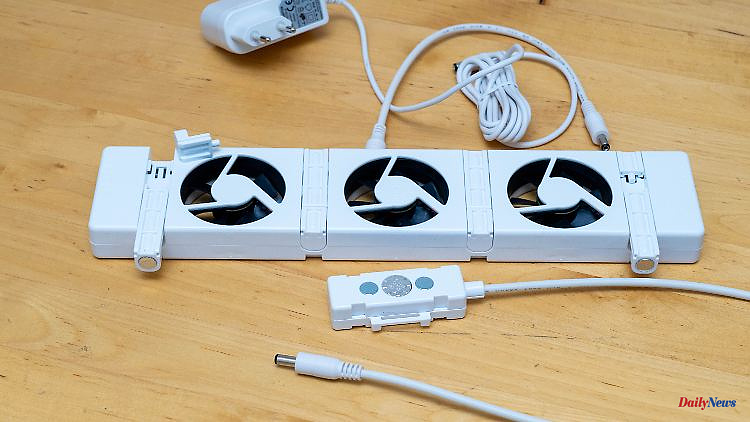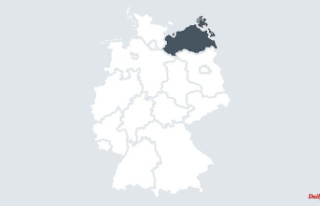With radiator fans you can save a lot of money with relatively little effort, in the test a living room warms up much faster with them. With the help of an installer you can get even more out of it, tenants should contact the property management before use.
As a rule of thumb, every degree of room temperature reduction reduces heating costs by around six percent. In addition, radiator fans can save a lot of energy and money, as they distribute the warm air in the room faster and more evenly, which means that the thermostat can be turned down earlier. Manufacturer SpeedComfort writes that its fans can heat a room in half the time. ntv.de has tried whether that is actually true.
The fans are similar to flat triple sockets, but have three small fans instead of slots. They cost around 60 euros individually, 105 euros in a double pack, and the manufacturer offers three for 150 euros. How many you need depends mainly on the size of a room. According to SpeedComfort, as a rule of thumb, one device is sufficient for 30 cubic meters (m³), two radiator fans are required for 60 m³, three for 90 m³ and so on.
That's quite a lot of money to invest. But if the devices keep what the manufacturer promises, they still pay for themselves relatively quickly in view of the rapidly increasing energy prices. The consumer advice center has calculated that, for example, a two-person household with 80 square meters now spends 1,990 euros per year on gas, which is 1,070 euros more than in 2021.
Before installation, you should definitely remove dust from the radiators, otherwise this will be blown into the air, which can be problematic, especially for people with allergies. It is best to use a special radiator brush for cleaning. In the case of heavily soiled radiators, this also increases the efficiency a little bit, as layers of dust have an insulating effect.
For the test, SpeedComfort provided ntv.de with four fans for a living room with around 110 m³ and two radiators. The assembly was done quickly. The devices have magnets on movable rails that attach to the underside of the radiators. Since the brackets can be attached in different ways, the fans are compatible with almost all radiators and convectors.
Since the radiators in the test room are relatively short, the SpeedComfort strips were attached offset - that's not a problem either. The fans are connected with a cable, theoretically you can connect up to 20 in series. At one end you plug in a thermostat, which also sticks magnetically to the radiator, at the other end is the power connection.
The power supply is the Achilles heel of the system. Because if there is no socket nearby, you have to use an extension or do without fans. SpeedComfort justifies the waiver of batteries with sustainability, among other things. The power consumption itself is very low. The manufacturer specifies costs of 32 cents for a fan with 1200 operating hours per year.
The fans start automatically as soon as the thermostat on the radiator measures 33 degrees, and switch off again at 25 degrees. You can hear them when they are in operation, the fans do not work silently, they are also louder than the 20 decibels specified by the manufacturer. But they buzz quietly enough not to be a nuisance when watching TV, for example.
ntv.de lacks the instruments to measure whether the living room is actually heated twice as fast with the fans. However, it feels like the room reaches the desired temperature much earlier and much more evenly with the fans than without. Setting the smart thermostat to 19 degrees (measured on the device) is sufficient to achieve a pleasant 20 degrees in the room.
In order to make the effect of the radiator fans visible, ntv.de borrowed the Seek Thermal ComactPro clip-on thermal imaging camera. The recordings clearly show that the warm air rises more quickly and evenly after the fans have been activated.
House and apartment owners or owners of a gas heating system can save even more. Because the use of fans makes it possible to lower the temperature of the heating water in general. You can also hire an installer to optimize the hot water flows to the radiators. Overall, SpeedComfort estimates the savings potential at 22 percent.
Tenants may have to do without it entirely. There are reports and comments that the use of such fans is not permitted if consumption is determined using heat cost allocators located on the radiators. It is then said to be an illegal manipulation of the measuring devices. The achieved performance is higher than the reading, which gives you an advantage over your neighbors, so the argument goes.
It seems questionable whether the use of radiator fans is actually illegal. The service provider BFW writes that heat cost allocators are generally tamper-proof. Minol Messtechnik takes a similar view in an information brochure. The only effective method is blowing with a (large) fan with 0.6 m³ per second. But that leads to high power consumption, it says. To be on the safe side, tenants with heat cost allocators on the radiators should get the permission of the landlord or property management before installing radiator fans.












